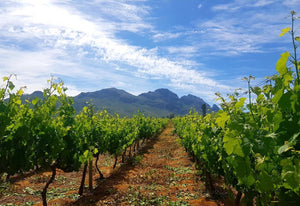South Africa has a long and proud history of wine production, dating back to 1659 when the first vineyards were planted in Cape Town. Since then, South African wines have consistently been among the most highly regarded in the world. The country's diverse climate, altitude and soils allow for a wide range of grape varieties to be grown, and producers have developed a unique style that combines the best of Old World and New World traditions.
The majority of vineyards are located around the coastline of the Cape, where the cooling influences are more prominent, thanks to the cold Benguela Current which flows up from the Antarctic. Also, there is a regular strong wind in the summer, know as the Cape Doctor, which can reach vineyards that are located further inland. Another important feature is the mountains, which spread throughout the wine growing regions, providing a range of different soils and style of wines produced.

Chenin blanc is a versatile grape variety that is the most widely planted variety in South Africa. The wines made from Chenin blanc grapes can range from dry to sweet, and the variety is also used to make sparkling wine. The flavours of Chenin blanc wines are typically quite fruity, with notes of green apples, pears, and citrus fruits. There can also often be a hint of honey in the taste. The acidity level of Chenin blanc wines can also be quite high, which makes them refreshing and food-friendly. Overall, Chenin blanc wines are well-balanced and easy to drink.

One of the most popular areas for growing Cabernet Sauvignon is the Stellenbosch region, located in the Western Cape province, stretching from the coast up into the mountains. The region enjoys a moderate to warm climate, with plentiful rainfall during the winter months. This creates ideal conditions for ripening Cabernet Sauvignon grapes, resulting in full-bodied wines with intense fruit flavours and firm tannins. The Stellenbosch region is also well-known for producing excellent Merlot wines. These wines tend to be softer and more approachable than their Cabernet Sauvignon counterparts, with plush fruit flavours and velvety tannins, to help produce world class Bordeaux style blends.
Another major area for growing Cabernet Sauvignon is the Paarl region, located just to the North of Stellenbosch. The climate here is slightly warmer and drier than in Stellenbosch, leading to richly concentrated wines with ripe blackberry and plum flavours. Finally, the Pinotage grape - a cross between Pinot Noir and Cinsault, developed in South Africa and can be produced in a range of styles. Often blended with international varieties to make a ‘Cape blend’ with intense coffee and chocolate aromas.

The South African wine region of Constantia is located just outside Cape Town and is known for its production of sweet wines. The most famous wine from this region is the Vin de Constance, which is made from old vines that produce very low yields. The climate in Constantia is perfect for these old vines, as the cool maritime breeze helps to preserve the delicate sweetness of the grapes. The Vin de Constance is a highly sought-after wine, and only a limited amount is produced each year. As a result, it is often quite expensive and difficult to find. However, for those lucky enough to taste it, the Vin de Constance is truly a special wine that showcases the best of what the South African wine region has to offer.
Just north of Cape Town, there is the large district of Swartland, which has previously been known for producing high yields and inexpensive wine. However, following years of innovation, Swartland is producing premium wines from old vine Chenin Blancs and premium Syrah.
The Cape South Coast wine region of South Africa is home to the Elgin, Walker Bay and Hemel-en-Aarde wine regions, which produce premium chardonnay, sauvignon blanc and pinot noir wines. The climate in this region is cooler than in other parts of South Africa, which helps to produce wines with higher acidity levels and intense, fresh flavour profiles. The Elgin wine region is located in the foothills of the Hottentots-Holland Mountain range, and the vineyards here benefit from the cool ocean breezes that blow in from False Bay. These areas have the ideal conditions for grape growing, with the right mix of terroir, altitudes and coastal influences.


